Despite the numerous distinct species of birds throughout Ontario, some individuals are interested in learning more about the popular birds within Ontario.
A few of the most common birds across Ontario are as follows,
All-year backyard bird species across Ontario are
- White-breasted Nuthatch
- Blue Jay
- House Finch
- Hairy Woodpecker
- Northern Cardinal
- Red-breasted Nuthatch
- Mourning Dove
- Downy Woodpecker
- European Starling
- House Sparrow
- American Crow
- Red-bellied Woodpecker
Summer backyard birds across Ontario include the following species:
- Dark-eyed Junco
- Yellow-rumped Warbler
- Red-winged Blackbird
- Gray Catbird
- Chipping Sparrow
- Tree Swallow
- Common Yellowthroat
- Yellow-rumped Warbler
- Barn Swallow
- Northern Flicker
- Eastern Kingbird
- White-throated Sparrow
- American Robin
- Common Grackle
- Baltimore Oriole
- Cedar Waxwing
- Song Sparrow
- Yellow Warbler.
| Image | Name |
|---|---|
 | Black-capped Chickadee |
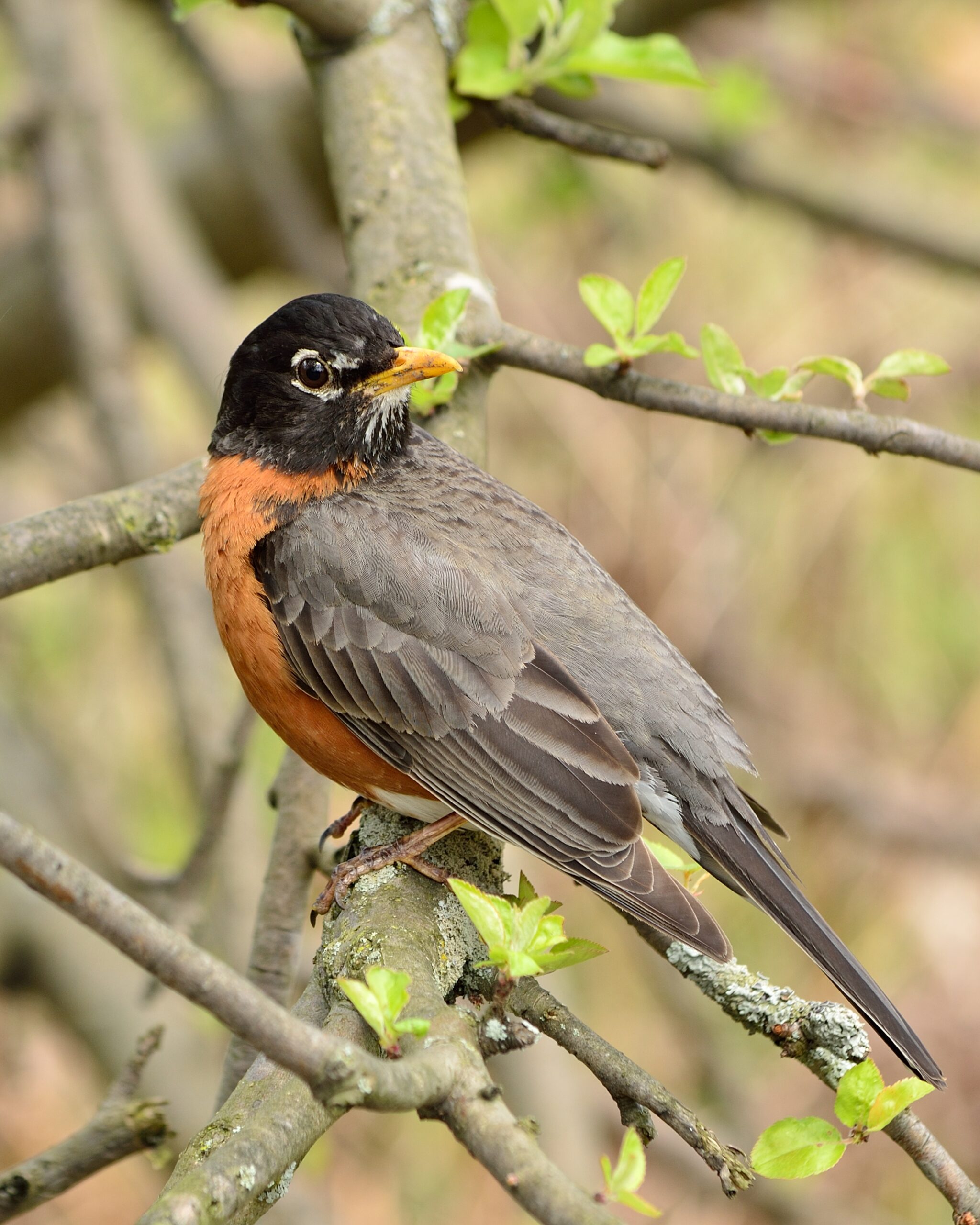 | American Robin |
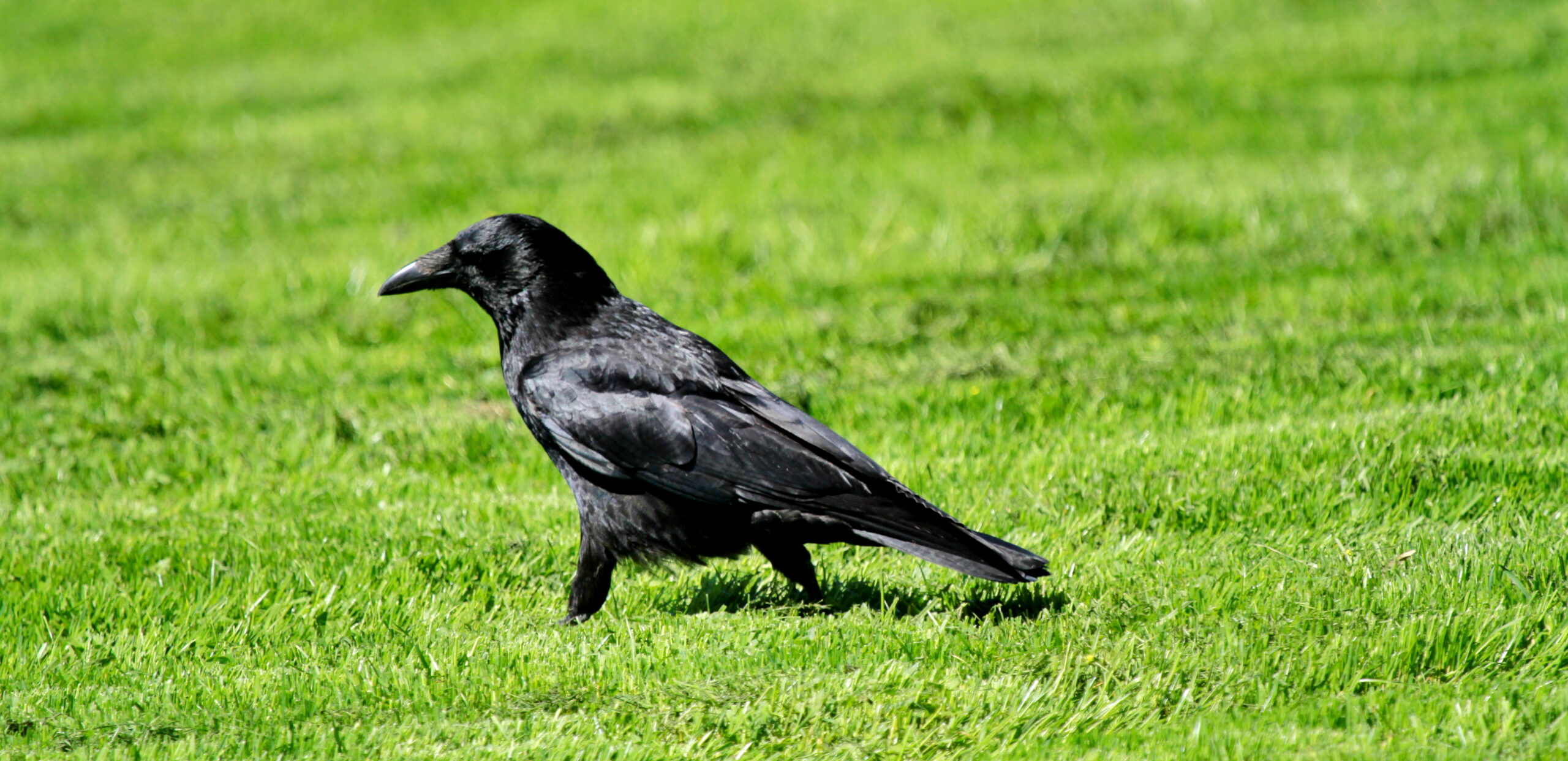 | American Crow |
 | Blue Jay |
 | American Goldfinch |
 | Mourning Dove |
Most Common Birds in Ontario
The Common Loon has been Ontario’s provincial bird. This bird was selected in 1994 and may be spotted in rivers and lakes throughout the province.
According to ebird, Ontario has 500 documented bird species.
The following birds can be found throughout Ontario:
- Green Heron
- Great Blue Heron
- Palm Warbler
- Cedar Waxwing
- Osprey
- Pileated Woodpecker
- Belted Kingfisher
- Rough-legged Hawk
- Ruby-throated Hummingbird
- Rose-breasted Grosbeak
- Bald Eagle
- Wild Turkey
- Indigo Bunting
- Baltimore Oriole
- Northern Harrier
- Scarlet Tanagers
- Double-crested Cormorant
- Sandhill Crane
- Turkey Vulture
- Snowy Owls
The below are among the most frequent birds throughout Ontario.
1. Black-capped Chickadee
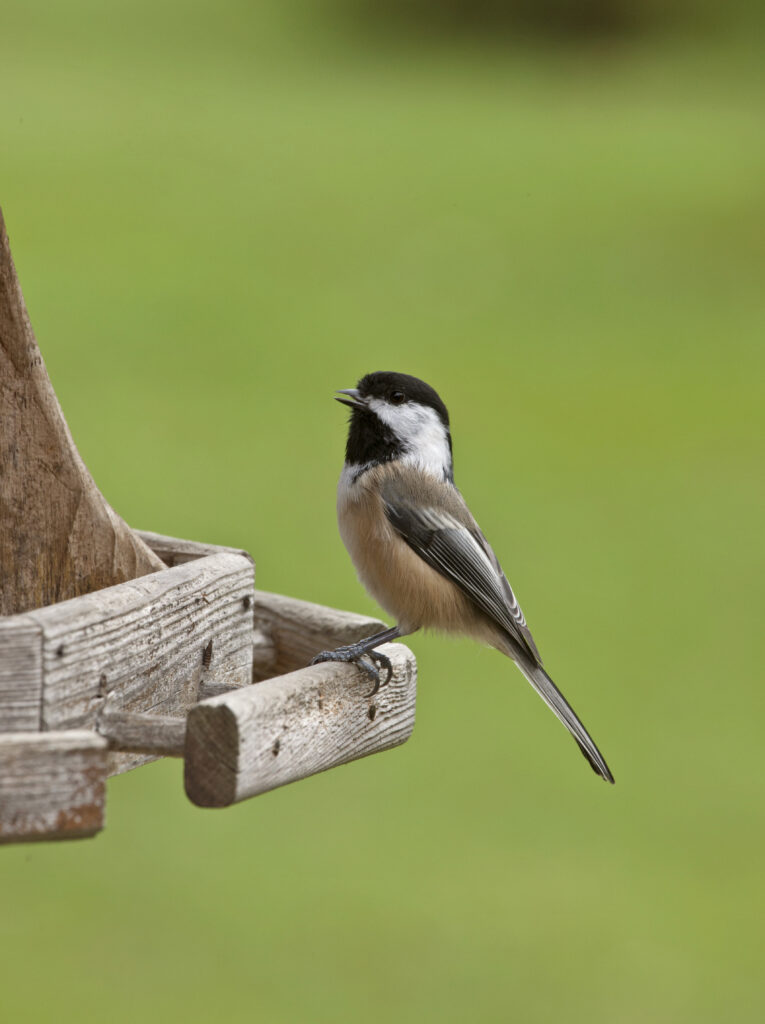
Black-capped Chickadees live in Ontario throughout the year. Although they appear on more checklists, mostly in winter, this is owing to the scarcity of other species.
They don’t really move and may be found on 54% of winter and 37 % of summer checklists.
The Black-capped Chickadee is perhaps a charming bird with a large spherical head and a little body. These birds will cheerfully feed from garden feeders and inspect anything and everything, including humans!
They possess black crowns and beaks, white faces, and grey wings, backs, and tails.
Black-capped Chickadees need not migrate and may be seen across the northern part of the United States and Canada.
Habitat & Food
They may be found in open woodlands, forests, and parks. The Black-capped Chickadee feeds on suet, spiders, insects, berries, and seeds.
Sunflower seeds, suet, peanut butter, and peanuts can entice Black-capped Chickadees toward your backyard. They may even eat from your hands and are frequently the very first birds to notice any feeders.
They may also use nesting boxes, particularly if they are filled with wood chippings.
| Scientific Name | Poecile atricapillus |
| Weight | 9 to 14 g (0.3 to 0.5 oz) |
| Length | 12 to 15 cm (4.8 to 5.9 in) |
| Wingspan | 16 to 22 cm (6.6 to 8.3 in) |
2. American Robin

American Robins spend the mating season across Ontario, where they may be seen on 63% of summer checklists.
They are mostly seen from March through October, although some stay throughout the year and appear on 9% of winter checklists.
American Robins are frequent in gardens, where they consume earthworms. Their backs and heads appear black, with orange or crimson chests.
Due to their preference to sleep in trees during the cold season, they are far more likely to appear in your yard beginning in the spring.
American Robins live across the lower 48 states, as well as along the coasts of Western Alaska and Canada. The one’s who breed within Canada and Alaska’s interior migrate south during winter.
Habitat & Food
American Robins may be located in a variety of environments, including forests, mountains, woodlands, fields, lawns, and parks. Their preferred foodstuffs are fruit, snails, insects, and earthworms.
Suet, sunflower seeds, fruit, peanut hearts, and mealworms will all entice American Robins into your backyard. Pedestal feeders or food spread throughout the grassland are best.
Plant several natural berry-producing plants, including sumac, dogwood, juniper, and hawthorn.
| Scientific Name | Turdus migratorius |
| Weight | 77 to 85 g (2.7 to 3.0 oz) |
| Length | 20 to 28 cm (7.9 to 11.0 in) |
| Wingspan | 31 to 40 cm (12.2 to 15.8 in) |
3. American Crow

American Crows are most commonly observed across Ontario during the mating season; however, they could also be found in the province’s southernmost of the year.
They occur on 38 % of summer checklists and 32% of winter checklists reported to the province via bird watchers.
Crows, mostly in the United States, are massive, all-black birds with a loud, cawing sound.
The majority of the lower 48 states, as well as the Pacific coasts of Alaska and Canada, have American Crows year around.
Those that nest within Canada and the northern Midwestern spend the winter mostly in the south.
They are ubiquitous birds encountered in a wide range of environments such as cities, woodlands, woods, fields, and beaches.
They eat almost everything and prefer to forage on the ground, where they consume insects, earthworms, fruit, and seeds. They also devour young turtles, clams, mussels, fish, eggs, and hatchlings of various bird species.
Mostly in winter, approximately two million American Crows congregate to nap in raucous communal roosts.
American Crows could be lured to your garden by sprinkling peanuts; however, they can be a problem if rubbish or pet food is left around.
| Scientific Name | Corvus brachyrhynchos |
| Weight | 315 to 620 g (11.3 to 21.9 oz) |
| Length | 40 to 53 cm (15.7 to 20.9 in) |
| Wingspan | 84 to 100 cm (33.6 to 39.4 in) |
4. Blue Jay

Blue Jays can be seen throughout the year in Ontario, mostly in the province’s southeast. They’re on 32% of winter and 38 % of summer checklists.
Blue Jays are huge songbirds having an erect blue crown, blue and black backs, and white lower parts that are frequent.
Blue Jays dwell the full year in eastern North America and southern Canada. Many birds will travel west during the winter, although not very often.
| Scientific Nam | Cyanocitta cristata |
| Weight | 70 to 100 g (2.6 to 3.5 oz) |
| Length | 25 to 30 cm (9.8 to 11.8 in) |
| Wingspan | 34 to 43 cm (13.3 to 16.9 in) |
They are loud birds that move within family groupings and consume acorns when they become accessible. They live in woodlands, primarily around oak trees, since they consume acorns.
They’re also common in back gardens around bird feeders. They eat grain, insects, seeds, and nuts in supplements to acorns. They might also steal hatchlings or eggs from nests.
Blue Jays are huge birds that love to come in, pick up a peanut or sunflower seed, then fly away to feast. They like station or tray feeders that allow them to depart quickly.
Peanuts, suet, and sunflower seeds are all favorites of blue jays. They like either pole-mounted hopper feeders or tray feeders. They could also appreciate a fountain.
5. American Goldfinch
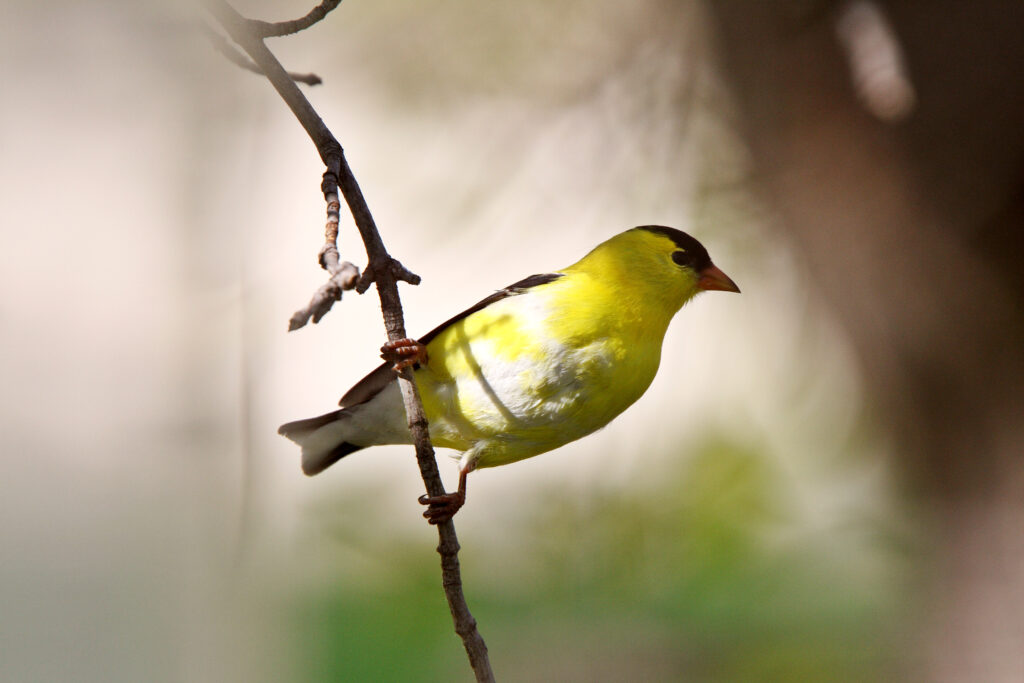
American Goldfinches across southern Ontario can be seen throughout the year, although their populations peak during the nesting season.
They are documented in 27 % of winter checklists, and 44 % of summer checklists are reported to the province by bird watchers.
American Goldfinches are famous birds during spring due to their striking yellow and black colors. Females and males are both duller brown in the winter season.
Most of North America is home to American Goldfinches, which are normally present throughout the year. On the other hand, some of those who breed in Canada and the Midwest move south during winter.
Habitat & Food
They can be seen foraging on thistle, sunflower, and aster plants in weedy meadows and overgrown places. They’re also prevalent in parks, backyards, and neighborhoods.
Plant milkweed and thistles to entice American Goldfinches toward your backyard. Most bird feeders may attract them and enjoy nyjer and sunflower seeds.
You may get to know a surprisingly large number of finches throughout Ontario.
| Scientific Name | Spinus tristis |
| Weight | 11 to 20 g (0.4 to 0.7 oz) |
| Length | 12 to 14 cm (4.4 to 5.2 in) |
| Wingspan | 19 to 22 cm (7.5 to 8.7 in) |
6. Mourning Dove
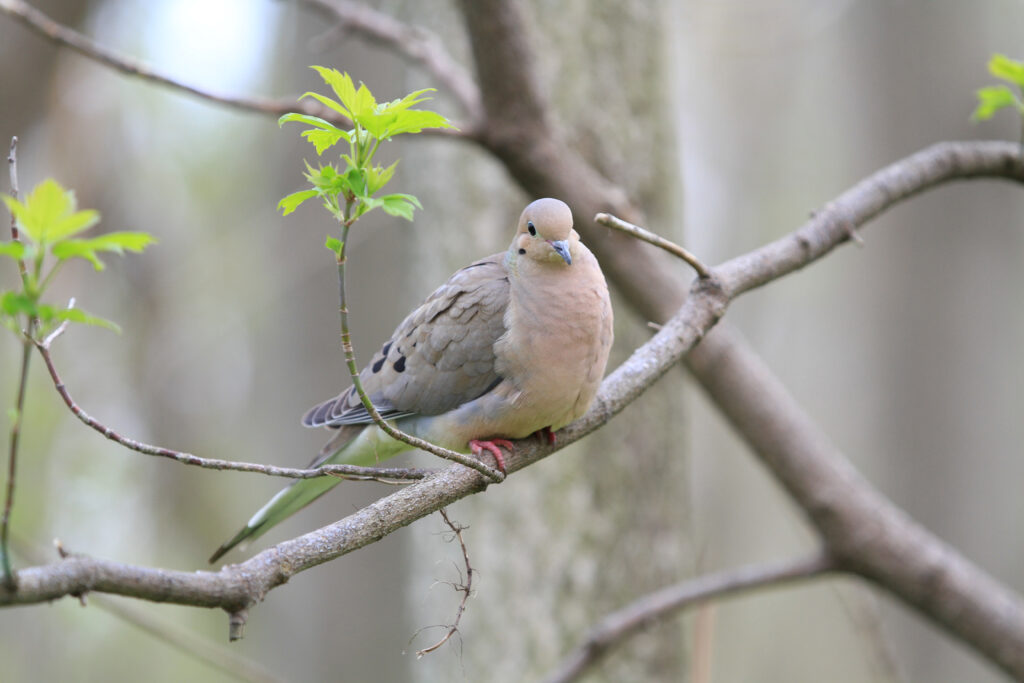
Mourning Doves are present in Ontario year around, although they are most prevalent during the mating season. They appear on 27 % of winter and 36 % of summer checklists.
Mourning Doves are tiny, elegant birds having plump bodies and long tails. Their wings are a delicate brown tint with black markings. Males weigh somewhat more than females.
Mourning Doves could be spotted perched on telephone lines and hunting for seeds across farms, meadows, and backyards. They may also be encountered in open places or at the borders of woodlands.
Mourning Doves can always be drawn to your yard by scattering millet as well as using platform feeders. Other favorites include cracked corn, nyjer, black sunflower seeds, and peanut hearts.
| Scientific Name | Zenaida macroura |
| Weight | 3.1 to 6.0 oz (96 – 170 g) |
| Length | 9.2 to 13.4 in (22 to 34 cm) |
| Wingspan | 17.7 in (45 cm) |
Check out this article on Common Birds in Manitoba.
Conclusion
Canada is a big nation having diverse scenery. Ontario is among the greatest areas to watch birds.
There are several sorts of environments in which a bird may be found. Water birds can be seen in your garden or parks, but you’ll need to venture farther into the woods to view them.
FAQ
What is Canada's most frequent bird?
Without the need for a question, the Northern Cardinal is among Canada’s most recognized birds. They are not just colorful but also frequent at bird feeders!
Last Updated on March 22, 2023 by Lily Aldrin
